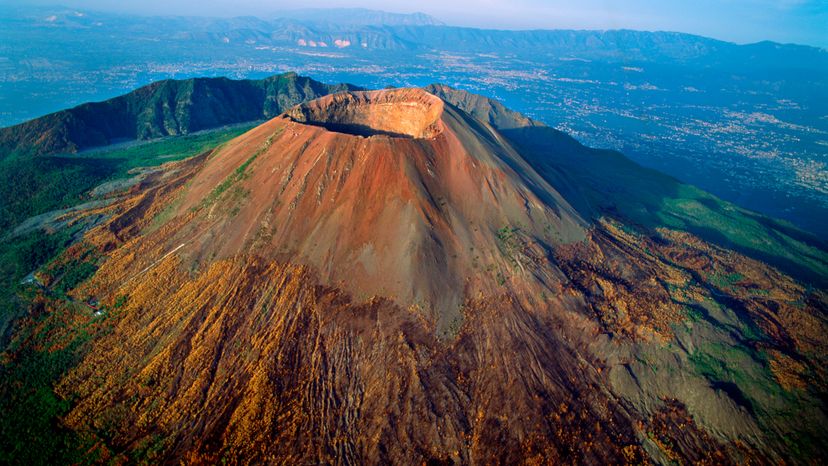
Advertisement

Advertisement
When it comes to Italy's Mt Vesuvius, it isn't a question of if it erupts but when. Geologists and volcanologists who study the volcano readily concede that Mount Vesuvius is overdue for an explosion [source: Fraser]. For that reason, the Vesuvius Observatory monitors seismic activity, gas emissions and other indicators 24 hours a day to know at the earliest point when it may blow.
The infamous volcano is best known for its nearly instantaneous decimation of neighboring towns Pompeii and Herculaneum in A.D. 79. Considered one of the world's most dangerous, it is also the only active volcano on Europe's mainland. Nevertheless, 700,000 people live in the 18 towns at its base that comprise the "red zone."
Advertisement
The red zone denotes the populated area that would bear the brunt of an eruption. Directly in the line of fire, the 9-mile (12-kilometer) radius of people stand little chance of survival when Vesuvius explodes again.
Vesuvius primarily erupts andesite, a volcanic rock with a silica content of around 53-63%. This type of lava leads to explosive eruptions, making Vesuvius a particularly unpredictable and hazardous volcano.
Because of the imminent -- and unpredictable -- threat, the Italian government has devised an evacuation plan to clear out the red zone 72 hours ahead of an impending volcanic eruption. Beginning in 2004, the government also set up a program to pay people $46,000 (30,000E) to relocate outside of the zone -- though it has had relatively few takers. Experts warn that emergency plans should also include nearby Naples since an explosion could send dangerous burning hot ash and pumice as far as 12 miles (20 kilometers) [source: Fraser].
Mount Vesuvius is considered a somma-stratovolcano. Stratovolcano volcanoes possess steeper slopes and exhibit a more conical shape compared to shield volcanoes. They originate from thick, adhesive lava caused by pyroclastic flows that doesn't spread smoothly. As a result, the lava accumulates around the opening, leading to the creation of a volcano with pronounced inclines looking like a large mountain from afar. A somma volcano, sometimes referred to as a sommian, represents a volcanic caldera that has been partially overlaid with a fresh central cone.
Advertisement

Mount Vesuvius is located in the Campania region in the country of Italy on the continent of Europe. The volcano is situated just east of the Bay of Naples. It's about 9 km (5.6 miles) east of the populous city of Naples. Mt. Vesuvius sits within the Campanian volcanic arc, a series of volcanoes that emerged due to a subduction zone from the merging of the African and Eurasian tectonic plates.
Advertisement
At 1 p.m. on August 24, A.D. 79, it began. Nineteen hours later, the two wealthy Roman cities of Pompeii and Herculaneum were almost erased from history. Signs of the incoming blast included a minor earthquake and underground water sources running out a few days prior [source: Stewart]. A plume of smoke rocketed 20 miles (32 kilometers) into the air from Vesuvius' opening, spewing forth its blisteringly hot contents.
The only eyewitness to account the eruption, Pliny the Younger, compared the smoke shooting up from Mount Vesuvius to an umbrella pine tree, the iconic feature of a plinian eruption. Soon, the city was engulfed in smoke and noxious volcanic gases from the mountain. Although most people escaped Pompeii, at least 2,000 who stayed behind were crushed or buried alive in the ash and rock or entombed in the volcanic mud that rained from the sky and poured down from the mountain that day.
Advertisement
Among the dead was Pliny the Youngers uncle a famous Roman named Pliny the Elder. He was a Roman writer, philosopher, naturalist and military and naval leader during the early Roman Empire.
Meanwhile, on the other side of the mountain at the Bay of Naples, the seismic storm traveled to Herculaneum. In addition to clouds of ash and rock came a heat wave of almost 900 degrees Fahrenheit (482 degrees Celsius) [source: Lorenzi]. Many were able to escape the wrath of the volcano, but 80 bodies were found -- seemingly frozen in time -- killed instantly by extreme thermal shock.
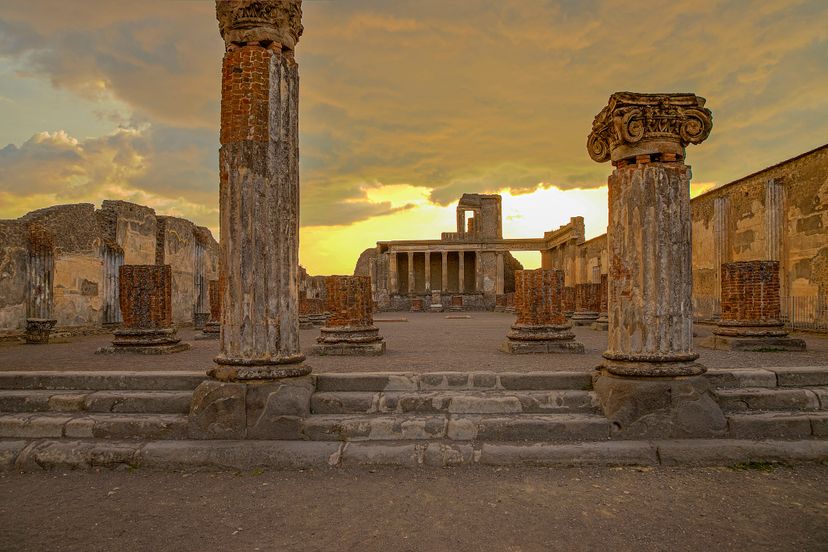
The A.D. 79 eruption buried Herculaneum in 75 feet (22 meters) of ash, while Pompeii remained under about 9 feet (2.7 meters). Since the area surrounding Mount Vesuvius was uninhabitable for centuries following the explosion, the cities eventually drifted from history, until 1748. Because of the fine dust and the speed at which it fell, Pompeii in particular was for the most part preserved intact. Architectural elements, artifacts and the hundreds of bodies stood unchanged until their excavation.
What archeologists didn't know until more recently was that the famous eruption was not the first or the largest from Mount Vesuvius. About 3,780 years ago, it burst open with more power, converting thousands of miles of landscape into desert for more than 200 years [source: Than]. Referred to as the Avellino eruption, it evidently caught thousands of inhabitants by surprise as well -- archeologists discovered deeply embedded footprints in the surrounding area.
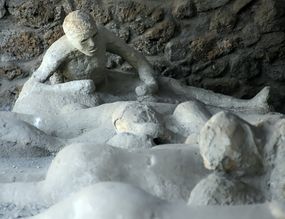
A 1631 eruption killed 4,000 people and destroyed six villages [source: Woods]. In modern times, only one minor eruption occurred in 1944, resulting in 26 fatalities. Although geologists today can predict the severity of the next eruption, they cannot pinpoint a date, making Mount Vesuvius a ticking time bomb.
Advertisement
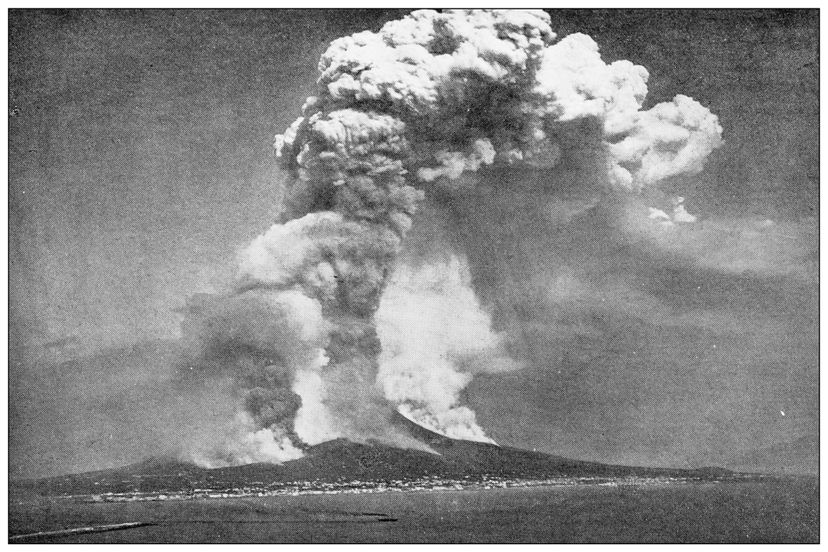
Please note that in the following list, "VEI" stands for the Volcanic Explosivity Index. This index gauges the intensity of volcanic eruptions. Christopher G. Newhall from the United States Geological Survey and Stephen Self introduced it in 1982. It was created as a way to determine the explosivity value of an eruption with 0 being the most mild and 8 being the highest index recorded to date.
| Date | VEI | Est. Deaths |
| 79 | 5 | 16,000 |
| 172 | 3 | |
| 203 | 4 | |
| 235 | 2 | |
| 395 | 2 | |
| 472 | 5 | |
| 512 | 4 | |
| 685 | 4 | |
| 787 | 3 | |
| 968 | 4 | |
| 991 | 3 | |
| 999 | 3 | |
| 1006 | 3 | |
| 1037 | 3 | |
| 1139 | 3 | |
| 1150 | 3 | |
| 1500 | 2 | |
| 1570 | 1 | |
| 1632 | 5 | 4,000 |
| 1652 | 2 | |
| 1680 | 3 | |
| 1682 | 3 | |
| 1694 | 3 | |
| 1696 | 2 | |
| 1697 | 3 | |
| 1701 | 3 | |
| 1708 | 3 | |
| 1730 | 3 | |
| 1737 | 3 | |
| 1743 | 1 | |
| 1761 | 3 | |
| 1767 | 3 | |
| 1779 | 3 | |
| 1794 | 3 | 18 |
| 1822 | 3 | |
| 1834 | 3 | |
| 1839 | 3 | |
| 1850 | 2 | |
| 1855 | 3 | |
| 1861 | 3 | |
| 1868 | 2 | |
| 1872 | 3 | |
| 1906 | 4 | 218 |
| 1944 | 3 | 28 |
The last eruption was in 1944, during World War II, causing minor damage and killing 26 people. Lava flows were observed overflowing from Vesuvius' crater. What began as minor eruptions gradually intensified over a week and a half, culminating in a significant explosion but giving enough time for most to evacuate.
Advertisement
New research has shown that the mountain probably will not act as kindly next time. For starters, Mount Vesuvius sits on top of a layer of magma deep in the earth that measures 154 square miles (400 square kilometers) [source: Noble]. That's a lot of magma -- Kilaeua Volcano is probably the most active volcano in the world, with 34 eruptions since 1952 [source: U.S. Geological Survey], but compared to Vesuvius, which has erupted around 30 times since 79 A.D. [source: Than], its magma supply is much smaller. Topping it off, scientists expect that the next eruption will be an incredibly forceful explosion, termed plinean, marked by flying rock and ash at speeds of up to almost 100 miles per hour (160 kph).
The period of tranquility since 1944 is notably longer than any recent times, suggesting a potential shift in Vesuvius's activity patterns. Some theories propose that the 1944 eruption concluded a phase of heightened activity. Based on these theories, the next significant eruption could occur in either a few decades or as long as several centuries. Major eruptions from Mt. Vesuvius, which release around 1 cubic kilometer or .24 cu mi of volcanic material and include the infamous one that buried Pompeii and Herculaneum, tend to occur after several thousand years of dormancy.
Advertisement
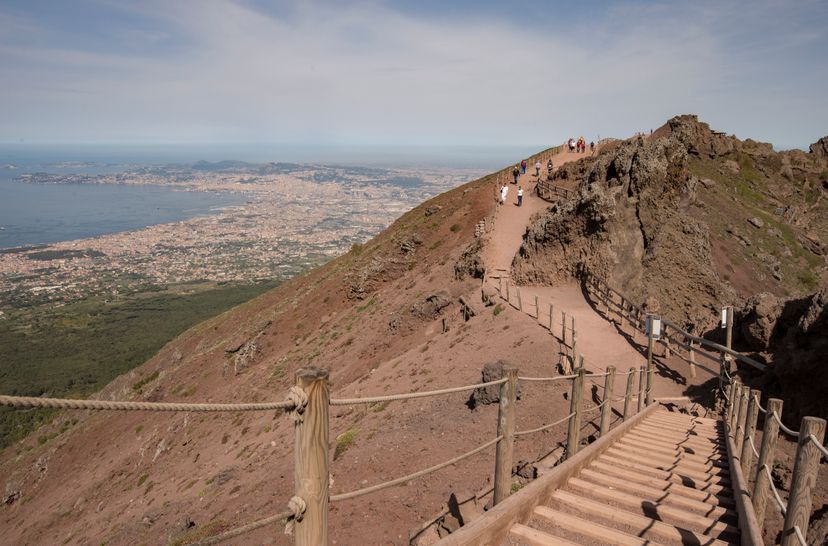
On 5 June 1995, the region surrounding Vesuvius was formally designated as a national park. Tourists can access the peak of Vesuvius, and the park officials maintain a series of trails around the volcano for exploration.
Mount Vesuvius, with its towering presence and rich history, is a magnet for tourists from every corner of the globe. This iconic volcano, which once buried the ancient cities of Pompeii and Herculaneum in a cataclysmic eruption, now stands as a testament to the power of nature and the resilience of human civilization.
Advertisement
The archaeological sites of Pompeii and Herculaneum, preserved under layers of ash and pumice, offer a unique window into the daily lives of ancient Romans. Walking through these cities is like stepping back in time, with streets, homes, and even some artworks remaining largely intact. These sites provide a tangible connection to history, making them a must-visit for history enthusiasts, archaeologists, and curious travelers alike.
Beyond the historical allure, the natural beauty of Mount Vesuvius and its surroundings is a draw in itself. The mountain offers panoramic views of the Bay of Naples, and its unique flora and fauna make it a hotspot for nature lovers. The Vesuvius National Park, established to protect the biodiversity of the region, offers a range of hiking trails that cater to both casual walkers and seasoned trekkers.
The combination of its dramatic history, archaeological wonders, and natural beauty makes Mount Vesuvius a bucket-list destination. In 2017, the Vesuvian archaeological sites attracted a total of 4,023,900 visitors. And still every year, millions of tourists, captivated by tales of ancient violent eruptions and the promise of breathtaking vistas, flock to this region, making it one of Italy's top tourist attractions.
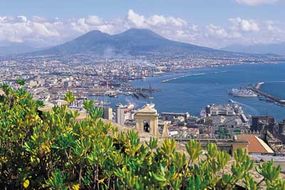
If Mount Vesuvius erupts today, it wouldn't be a pretty picture. Given its potential, Vesuvius could endanger more than 3 million people and wipe out the city of Naples [source: Than].
Today, Italy potentially faces a dual crisis centered around Mount Vesuvius. Firstly, Vesuvius is an active volcano with the potential to erupt at any moment, powerful enough to obliterate entire cities, reminiscent of its destruction of Pompeii and Herculaneum in A.D. 79. Secondly, the mountain has become a focal point of a national "squatter" dilemma, with over 700,000 people residing illegally on its slopes.
Across Italy, an estimated 6 million people live in unlawfully built homes, a consequence of years of governmental mismanagement, from sheer incompetence to blatant corruption. The rapid urbanization of Italy during the mid-20th century saw developers hastily constructing homes that catered to public demand but often violated building codes. The government's typical response has been to implicitly support, and sometimes even directly participate in, the bypassing of its own regulations.
This unchecked urbanization has rendered Vesuvius one of the world's most hazardous volcanoes. Lucia Pappalardo, a volcanologist, senior researcher at the Vesuvius Observatory, and Naples native, emphasizes that a catastrophic eruption is unpredictable and the only way to ensure the safety of the populace is through a preventive evacuation, a complex task given the area's dense population and insufficient escape routes.
The Italian government has largely ignored these evident risks for years. It wasn't until the 1980s that the state began restricting urban growth around Vesuvius, designating certain areas as "red zones." However, these restrictions came with loopholes, allowing continued construction in these zones in exchange for amnesty payments putting people at great risk and living on the edge until the next eruption occurs.
Advertisement
Advertisement